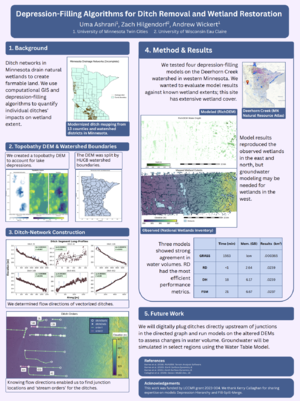2025 CSDMS meeting-117
From CSDMS
(if you haven't already)
Log in (or create account for non-CSDMS members)
Forgot username? Search or email:CSDMSweb@colorado.edu
Browse abstracts
Simulating Ditch Removal and Wetland Restoration Using Depression-Filling Algorithms
Uma Ashrani,
University of Minnesota Minneapolis Minnesota, United States. ashra061@umn.edu
Zach Hilgendorf, University of Wisconsin - Eau Claire Eau Claire Wisconsin, United States. hilgenzt@uwec.edu
Andrew Wickert, University of Minnesota Minneapolis Minnesota, United States. awickert@umn.edu
Minnesota’s drainage-ditch network facilitates agriculture by draining standing water, but disrupts hydrological connectivity and the water extent of wetlands. These wetlands are critical for ecosystem health, water filtration, carbon storage, and flood protection (e.g. Hansen et al. 2018, Office of Water 2002). Cowdery et al. (2019) investigated a case study of wetland restoration in western Minnesota, but the study region experienced variable precipitation and environmental factors across pre- and post-restoration periods. In our project, we systematically model drainage-ditch removal and wetland restoration across all Minnesota watersheds. Using computational GIS, we develop a topobathy digital elevation model, which accounts for depressions that currently store water. We run depression-filling algorithms (Barnes 2016, Barnes et al. 2020, Barnes et al. 2021) to first compute water storage in the current landscape. With information on current water storage in hand, we digitally infill drainage ditches and recalculate water storage and extent. These results will isolate the impacts of certain drainage ditches on surface water.
- Barnes, Richard. 2016. RichDEM: Terrain Analysis Software. http://github.com/r-barnes/richdem
- Barnes, R., Callaghan, K. L., & Wickert, A. D. Computing water flow through complex landscapes – Part 2: Finding hierarchies in depressions and morphological segmentations, Earth Surface Dynamics, 8, 431–445, https://doi.org/10.5194/esurf-8-431-2020, 2020.
- Barnes, R., Callaghan, K. L., & Wickert, A. D. Computing water flow through complex landscapes – Part 3: Fill–Spill–Merge: flow routing in depression hierarchies. Earth Surface Dynamics, 9, 105-121, https://doi.org/10.5194/esurf-9-105-2021, 2021.
- Cowdery, T., Christenson, C. A., Ziegeweid, J. The Hydrologic Benefits of Wetland and Prairie Restoration in Western Minnesota - Lessons Learned at the Glacial Ridge National Wildlife Refuge, 2002-15. U.S. Geological Survey Scientific Investigations Report 2019–5041, https://doi.org/10.3133/sir20195041, 2019.
- Hansen, A. T., Dolph, C. L., Foufoula-Georgiou, E., & Finlay, J. C. Contribution of wetlands to nitrate removal at the watershed scale. Nature Geoscience, 11, 127-132, https://doi.org/10.1038/s41561-017-0056-6, 2018.
- Office of Water & Office of Wetlands, Oceans, and Watersheds. Functions and Values of Wetlands. United States Environmental Protection Agency, EPA 843-F-01-002c March 2002, 2002.

